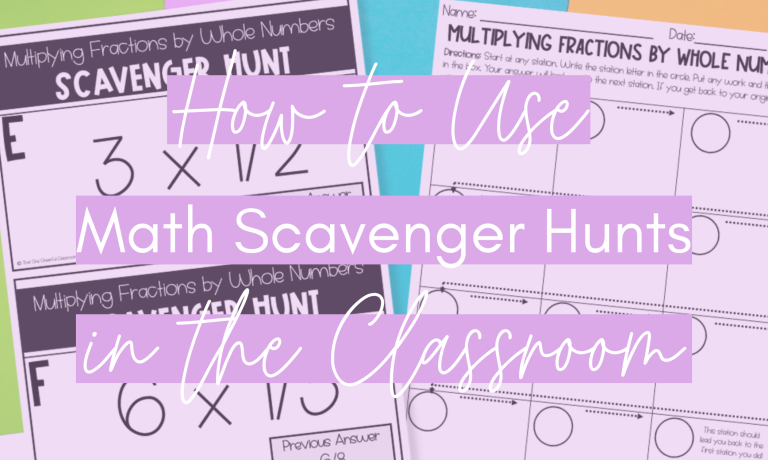Math scavenger hunts are a fun and engaging way to get students excited about learning math. These hunts involve students working together to solve math problems and clues that lead them to the next challenge. They can be used in a variety of settings, including the classroom, after-school programs, and even at home. In this blog post, we will explore how to use math scavenger hunts in the classroom to boost student engagement and understanding of math concepts.
How do math scavenger hunts work?
In a scavenger hunt activity, students can work independently or in pairs to solve math problems that are posted on each of the station cards. They can start at any station card and solve the problem that’s posted there.
Once they solve the problem, they find another card posted around that room with that solution located on the bottom corner of the card. The new station card will include another problem to solve.
Students solve the new problem, then find the station card with that answer on it. If students solve all of the problems correctly, they’ll move from card to card, then end up back at the station they started at.
Each student or pair can start at a different station and will move through the same loop of stations simultaneously.
What do students record while they’re working on the math scavenger hunts?
That’s up to you!
Some teachers have students record all of their work on a recording sheet that looks something like this:
Students record the letter of the first station they begin at, include all of their work for solving the problem, then find the card with that answer on it and continue the process.
Some teachers have students use individual whiteboards, since students are more likely to jump in and get started when working on a more fun surface than just paper and pencil. In this case, students could complete a paper based recording sheet where they track the order of the stations, but there isn’t any work shown. This helps them check to make sure they loop through the scavenger hunt and they went to every station.
How to Use a Math Scavenger Hunt
Any type of math problems can be added into a scavenger hunt. They require minimal prep once they are created because all you have to do is post them around the room, copy some recording sheets and have students get started.
Benefits of Using Math Scavenger Hunts in the Classroom
Here’s a quick rundown of the benefits of using scavenger hunts to practice math skills.
Scavenger Hunts Get Students Talking
If you choose to have your students work in pairs, they will be discussing how they solved the problems and thinking through things cooperatively. They can also talk about potential solution strategies, alternative strategies, or even troubleshooting incorrect answers if one of them didn’t solve correctly.
Scavenger Hunts Get Students Moving
Everyone loves movement, and it’s a great way to keep students engaged and on task. Scavenger hunts require movement all while working on important math skills! You can post scavenger hunts around your classroom or in a nearby hallway or outside to change the scenery for your students.
Scavenger Hunts are Self-Checking and Give Immediate Feedback
The nature of the scavenger hunt provides immediate feedback because if they can’t find their answer on another card, they know that they made a mistake in their solving of the problem. I usually talk to my students about What happens if we solve a problem… and then can’t find our answer on another card? Maybe our work has a mistake in it. Students can circle back to that station and troubleshoot their work.
We also talk about, Maybe our work is correct… and the answer we’re looking for is presented differently. This is another huge benefit of the scavenger hunt format! You can work on the equivalence of answers (like with fractions) or remembering to label answers (if you’re working with measurement).
Easy to Create from Instructional Materials
Scavenger hunts take careful planning and construction when making sure you place answers on the correct cards, but you can quickly build a scavenger hunt from any set of mathematical concepts questions you already have handy. Put the questions on the cards, write a key for a random order that you want to use to have the students loop through, I like to use Random.Org’s list generator, then put the solutions on the cards according to your answer key.
Frees the Teacher Up to Help Those Needing Extra Assistance
With students up and working around the room, the teacher can move from student to student to provide help to those who need it. You can also use this time to pull small groups and work on any skills that the students need to work on to get to mastery. The students working around the room will be able to use the scavenger hunt as a math center activity and will provide meaningful math practice within your math centers time.
Ready Made Math Scavenger Hunts
These scavenger hunts are so much fun for students and will feel like they are playing a fun math game. Don’t want to create them yourself? Here are some scavenger hunts I’ve put together to save you time with planning and creating:
3rd Grade Math Scavenger Hunts
4th Grade Math Scavenger Hunt Bundle
5th Grade Math Scavenger Hunts
Want to try a math scavenger hunt activity with your class for free?
Click here to grab my 4 digit division scavenger hunt activity for free to try out.


One Response
I love the scavenger hunts. I used a division one with my 4th graders last year. It was a lot of fun! The hunt for the next problem to complete is exciting for the students.